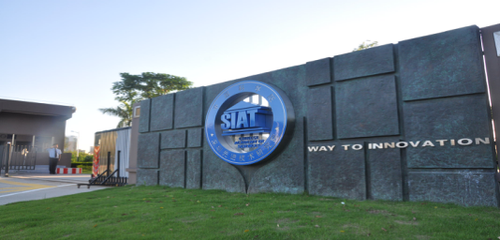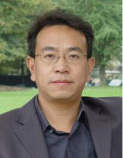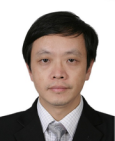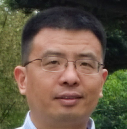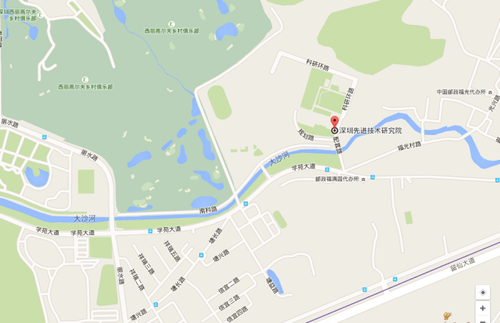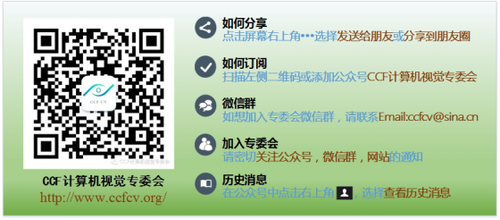CCF-CV走进高校系列报告会(第二十二期,中国科学院深圳先进技术研究院)
中国计算机学会计算机视觉专委会走进高校系列报告会
CCF-CV Series Lectures
中国科学院深圳先进技术研究院·深圳(第22期)
2016年10月28日(星期五)09:00-12:10
中国科学院深圳先进技术研究院A区报告厅
计算机视觉前沿技术及应用
程 序
9:00 签到
9:30 报告会开始
特邀讲者:刘宏 教授,北京大学教授
演讲题目:OnlineGrowing Neural Gas for Anomaly Detection in Changing Surveillance Scenes
特邀讲者:金连文 教授,华南理工大学教授
演讲题目:Dropto Gain ——浅谈深度学习中的舍弃训练技术及其应用
特邀讲者:俞 栋 博士,微软雷德蒙研究院 研究员
演讲题目:PermutationInvariant Training of Deep Models for Speaker-Independent Multi-Talker SpeechSeparation
特邀讲者:赖剑煌 教授,中山大学教授
演讲题目:行人再标识问题的若干研究新进展
执行主席:乔宇博士,中国科学院深圳先进技术研究院集成所副所长、研究员
中国计算机学会计算机视觉专委会委员
报名方式:Email:mmlab_siat@163.com(请于10月26日前将参会回执回复至该邮箱,邮件主题请注明“CCF-CV中国科学院深圳先进技术研究院报告会回执”)
参加方式:免费参加,敬请光临。
参会回执
姓名 | 职称/职务 | ||
电话 | |||
工作单位 | |||
注:回执仅仅针对外地和外校的人员,本校人员无需提供。
特邀讲者刘 宏 教授
刘宏,工学博士,北京大学教授,博士生导师,国家《高层次人才特殊支持计划》(万人计划)首批专家,科技部“国家中青年科技创新领军人才”,中国人工智能学会副理事长,全国智能机器人创新联盟副理事长,深圳市政协委员(科学技术界)。Elsevier出版CAAITransaction on Intelligence Technology 国际期刊主编。
刘宏教授长期从事智能机器人视觉听觉及运动规划领域的教学、科研和产业化工作,先后师从著名机器人专家蔡鹤皋院士、著名模式识别专家石青云院士和国家最高科学技术奖获得者王选院士。承担国家自然科学基金项目、国家863课题和国家973课题10余项,在IEEE TCYB, TMM,TSP, PR, IJCAI,ICRA,IROS等重要国内外学术期刊和学术会议上发表论文200多篇,申报/获得国家发明专利30多项。获国家航天科技进步奖、日内瓦国际发明博览会奖、吴文俊人工智能科学技术奖、CAAI全国青年论坛“最佳青年科技成果奖”和北京大学教学优秀奖、北京大学十佳教师候选人等荣誉。
刘宏教授是智能机器人领域科技创新的潜心实践者,2013年成为全国智能机器人领域首批入选“万人计划”的五位学者之一;同时又是我国智能科学与技术新学科建设的积极倡导者,参与创建全国第一个智能科学系和智能科学技术专业, 培养了100多名硕士、博士和博士后等人工智能和机器人领域的专业人才。
报告摘要:Anomaly detection is still a challenging task for video surveillance dueto complex environments and unpredictable human behaviors. Most existingapproaches train offline detectors using manually labeled data and predefined parameters, andhard to model changing scenes. This paper introduces a neural network basedmodel called online Growing Neural Gas (online GNG) to perform the unsupervised learning. Unlike the fixed-parameter GNG, our model updates learning parameters continuously,for which several online neighbor-related strategies are proposed. In terms ofspecificoperations, neuron insertion and deletion, learning rate adaption, and stopcriteria selection all get upgraded to online modes. In the anomaly detectionstage, the behavior pattern far away from our model is labeled as anomalous,where the far away is measured by a time varying threshold. Experiments areimplemented on three surveillance datasets, namely UMN, UCSD Ped1/Ped2 andAvenue dataset. All of them have changing scenes due to mutable crowd densityand behavior types. Detection results show that our model can adapt to thecurrent scene rapidly and reduce false alarms while still detecting mostanomalies. Quantitative comparisons with 12 recent approaches confirm our superiorityfurther.
特邀讲者金连文 教授
金连文,男,1991年本科毕业于中国科技大学获无线电新技术专业及计算机软件及应用技术专业双学位,1996年于华南理工大学获博士学位。2006入选教育部新世纪优秀人才,2011年入选广东省“珠江学者”特聘教授。目前为华南理工大学二级教授,兼任中国图像图形学学会常务理事、CCF计算机视觉专委会委员、CCF人机交互专委会委员、中国人工智能学会模式识别专委会委员、广东省图像图形学会副理事长等职。主要研究领域为文字识别、机器学习、计算机视觉、人工智能等。在IEEETNNLS、IEEETCYB、IEEETSMC、IEEETMM、IEEEIS、IEEETCSVT、InformationScience、PatternRecognition等主流SCI国际期刊上发表学术论文30余篇,主流国际会议论文50余篇。Google Scholar引用次数6000余次。获得发明专利授权35项。先后主持了包括5项国家自然科学基金、科技部国家科技支撑计划、广东省重大科技项目等在内的科研项目50余项。作为主要成员荣获省部级科技奖三次。
报告摘要:深度学习近年来在计算机视觉等实际应用领域取得巨大成功的重要因素之一,得益于诸如Dropout、ReLU、BatchNormalization、DataAugmentation等一系列新的训练方法及训练思想的提出及应用。其中,Dropout等技术能有效防止过拟合并提升模型泛化性能。在本报告之中,我将简要回顾深度学习领域中Dropout、DropConnect等多种基于舍弃思想的训练技术,介绍我们提出的几种Drop Learning(DropSample、DropStroke、DropSegment、DropRegion)训练方法及技术,及其在文字识别中的应用,并展示相关的应用演示系统。
特邀讲者 俞 栋 博士
Dr. Dong Yu is a principalresearcher at the speech and dialog research group, Microsoft Research, wherehe joined in 1998. His research has been focusing on speech recognition andother applications of machine learning techniques. He has published twomonographs and more than 160 papers in these areas and is theinventor/coinventor of over 60 granted/pending patents. His works have beencited for over 10,000 times with an h-index of 46 per Google Scholar, and havebeen recognized by the prestigious IEEE SPS 2013 best paper award and the ACMSE2005 best paper award.
Dr. Dong Yu’s most significant contribution tothe field is the proposal and development of the context-dependent deep neuralnetwork – hidden Markov model (CD-DNN-HMM) for speech recognition. This is thefirst successful application of the deep learning techniques to largevocabulary speech recognition, caused a paradigm shift in both industry andresearch community, and led to a series of significant advancements in speechprocessing. Dr. Dong Yu initiated and led the early effort in developing theopen source deep learning software – computational network toolkit (CNTK),which enabled to build various research and production deep learning systems inMicrosoft and many other organizations.
Dr. Dong Yu is a senior member of IEEE (M’97, SM’06). He is currently serving as amember of the IEEE Speech and Language Processing Technical Committee(2013-2018). He has served as an associate editor of the IEEE/ACM transactionson audio, speech, and language processing (2011-2015), an associate editor ofthe IEEE signal processing magazine (2008-2011), the lead guest editor of theIEEE transactions on audio, speech, and language processing – special issue ondeep learning for speech and language processing (2010-2011), a guest editor ofthe IEEE/CAA journal of automatica sinica – special issue on deep learning inaudio, image, and text processing (2015-2016), and members of organization andtechnical committees of many conferences and workshops.
报告摘要:We propose a novel deep learning model, which supports permutationinvariant training (PIT), for speaker independent multi-talker speechseparation, commonly known as the cocktail-party problem. Different from mostof the prior arts that treat speech separation as a multi-class regressionproblem and the deep clustering technique that considers it a segmentation (orclustering) problem, our model optimizes for the separation regression error,ignoring the order of mixing sources. This strategy cleverly solves thelong-lasting label permutation problem that has prevented progress on deeplearning based techniques for speech separation. Experiments on English andDanish corpuses confirms the effectiveness of PIT. We believe improvementsbuilt upon PIT can eventually solve the cocktail-party problem and enablereal-world adoption of, e.g., automatic meeting transcription and multi-partyhuman-computer interaction, where overlapping speech is commonly seen.
特邀讲者 赖剑煌 教授
赖剑煌,中山大学数据科学与计算机学院教授、博士生导师,中国计算机学会杰出会员,中国计算机学会计算机视觉专业组副主任,广东省信息安全重点实验室主任,广东省图像图形学会理事长,中国生物识别产业技术创新战略联盟常务理事IEEE高级会员,中国图像图形学会常务理事,中国图像图形学会学术委员会委员。1986、1989年分别在中山大学获学士、硕士学位,并留校任教。1999年在中山大学获博士学位。主要研究领域为生物特征识别、数字图像处理、模式识别和机器学习。已主持承担国家自然科学基金与广东联合重点项目1项,科技部科技支撑课题1项,国家自然科学基金4项等。已发表了约200篇学术论文,主要发表在ICCV、 CVPR、ICDM等专业重要学术会议以及IEEE TPAMI、IEEE TIP、IEEE TNN、IEEE T-SMC(Part B)、Pattern Recognition等国际权威刊物上。拥有多项国家发明专利。
报告摘要:行人再标识(person re-identification)问题,是视频监控、模式识别与计算机视觉领域的一个重要问题。报告首先综述该领域的研究进展,然后重点介绍本团队在行人再标识方向的若干研究进展,包括了基于时空线索的行人再标识、行人的动态匹配模型、行人的镜像表示、跨视域的鉴别成分分析、基于深度学习的再标识等方法。相关理论可应用于现实监控系统,对于图像搜索与匹配领域也具备一定借鉴意义。
会场路线图
CCF-CV 网站:http://www.ccfcv.ccf.org.cn/
CCF-CV公众号:
推荐内容
More >>>- · 第八十三期CCF-CV走进高校系列报告会于悉尼大学圆满结束
- · 第八十四期CCF-CV走进高校系列报告会于广东石油化工学院圆满结束
- · 第七十三期CCF-CV走进高校系列报告会于苏州科技大学圆满结束
- · 第七十四期CCF-CV走进高校系列报告会于河北大学圆满结束
- · 第七十期CCF-CV走进高校系列报告会于太原理工大学圆满结束
- · 第六十八期CCF-CV走进高校系列报告会于北京信息科技大学圆满结束
- · 第三届计算机视觉及应用创新论坛在广州举办
- · 第一届中国模式识别与计算机视觉大会在广州召开
- · CCF-CV专委会2018年度全体委员会议在广州成功举办
- · 【预告】CCF-CV走进高校系列报告会(第五十八期,广西师范学院)


